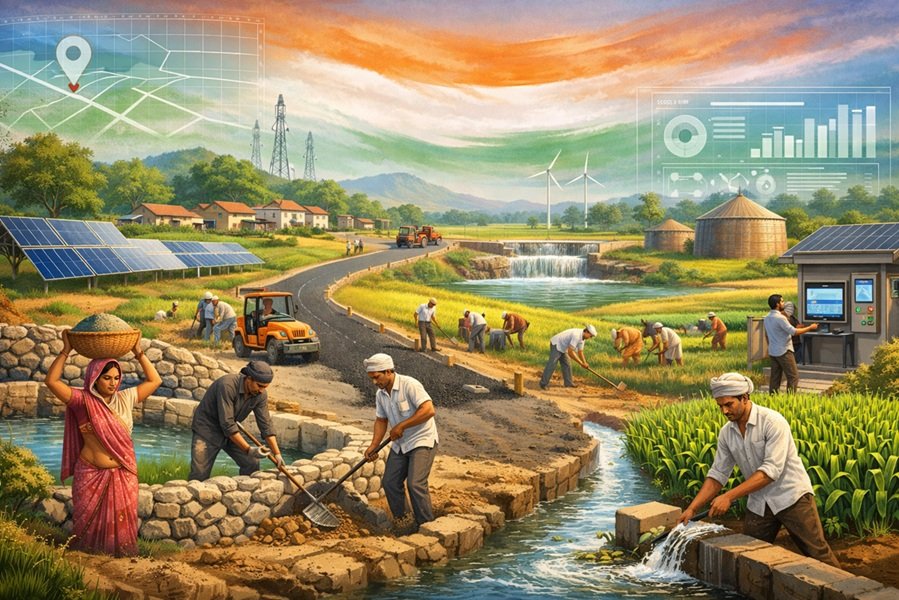
India Overtakes Japan to Become the World’s Fourth-Largest Economy in 2025: A Historic Shift in Global Economic Power
In a remarkable milestone for the global economy, India has officially surpassed Japan to become the world’s fourth-largest economy in 2025, according to the latest data released by the International Monetary Fund (IMF). This shift marks a significant moment in the ongoing reshaping of the global economic order and highlights India’s growing influence as a major economic powerhouse.
The 2025 Economic Rankings: A New World Order
The updated IMF report places India at the 4th position globally, with a nominal GDP of $4.19 trillion, edging slightly ahead of Japan, whose GDP also stands at $4.19 trillion but with a marginally lower trajectory. Here’s a look at the Top 10 Largest Economies in the World in 2025:
| Rank | Country | GDP (USD, Trillions) | 2025 Projected Real GDP Growth (%) | GDP Per Capita (USD) |
|---|---|---|---|---|
| #1 | United States | $30.51 T | 1.8% | $89,110 |
| #2 | China | $19.23 T | 4.0% | $13,690 |
| #3 | Germany | $4.74 T | -0.1% | $55,910 |
| #4 | India | $4.19 T | 6.2% | $2,880 |
| #5 | Japan | $4.19 T | 0.6% | $33,960 |
| #6 | United Kingdom | $3.83 T | 1.1% | $54,950 |
| #7 | France | $3.21 T | 0.6% | $46,390 |
| #8 | Italy | $2.42 T | 0.4% | $41,090 |
| #9 | Canada | $2.23 T | 1.4% | $53,560 |
| #10 | Brazil | $2.13 T | 2.0% | $9,960 |
Source: https://www.imf.org/external/datamapper/NGDPD@WEO/OEMDC/ADVEC/WEOWORLD
Read This: The Top 10 Largest Economies in the World 2025
India’s Economic Ascent: Drivers of Growth
India’s leap to the fourth position in global economic rankings is backed by several long-term structural strengths and recent reforms:
1. Strong GDP Growth Rate
India has consistently maintained one of the highest GDP growth rates among major economies. In 2025, its real GDP growth is projected at 6.2%, significantly higher than Japan’s 0.6%. This dynamic expansion is driven by strong domestic consumption, robust services exports, digital innovation, and infrastructure investment.
2. Demographic Advantage
India has the world’s largest young population, with a median age of around 28 years. This demographic dividend fuels its labor force, consumer base, and entrepreneurship ecosystem. Unlike Japan, which faces a shrinking population and aging workforce, India is reaping the benefits of its youthful energy.
3. Digital and Tech Transformation
India’s digital economy, including fintech, e-commerce, and IT services, is booming. The “Digital India” initiative, along with widespread smartphone and internet penetration, has unlocked massive growth potential. Global companies continue to invest in India’s tech talent and digital infrastructure.
4. Policy Reforms and Manufacturing Push
Reforms such as Goods and Services Tax (GST), the Insolvency and Bankruptcy Code (IBC), and initiatives like “Make in India” and PLI (Production Linked Incentive) schemes have improved the ease of doing business and attracted foreign direct investment (FDI).
Japan’s Sluggish Growth: A Contrast
While Japan remains a high-income and technologically advanced nation, its economic trajectory has been relatively stagnant in recent years due to:
- An aging and declining population, which limits labor supply and consumer demand.
- Deflationary pressures and low productivity growth.
- Modest innovation in emerging sectors, especially compared to newer growth engines like India and China.
- Structural rigidity in its corporate and labor markets.
Despite a strong GDP per capita ($33,960), Japan’s total output growth is lagging behind, and the economy is showing signs of long-term stagnation.
GDP Per Capita: India Still Has a Long Way to Go
Although India has overtaken Japan in overall GDP, the per capita income tells a different story. With a GDP per capita of just $2,880, India remains far behind most developed countries.
| Country | GDP Per Capita (2025) |
|---|---|
| United States | $89,110 |
| Germany | $55,910 |
| Japan | $33,960 |
| China | $13,690 |
| India | $2,880 |
This highlights the need for inclusive growth and improved living standards for India’s large population. Bridging this gap will require continued focus on education, healthcare, rural development, and job creation.
Global Implications of India’s Rise
India’s climb to the fourth-largest economy has significant geopolitical and economic implications:
1. Shift in Global Power Dynamics
India’s economic ascent strengthens its position in global forums such as the G20, BRICS, and World Trade Organization (WTO). It also bolsters India’s case for a permanent seat in the United Nations Security Council.
2. Investment Magnet
With its large market size, skilled workforce, and digital maturity, India becomes a top destination for global capital and innovation partnerships.
3. Asia’s Economic Rebalance
India’s growth offers a counterbalance to China in Asia, increasing its relevance in regional trade, diplomacy, and security frameworks such as QUAD and Indo-Pacific alliances.
Future Outlook: Can India Become the Third-Largest Economy?
If India continues on its current growth trajectory, it is projected to surpass Germany and become the third-largest economy by 2027 or 2028, depending on global trends. Continued momentum will depend on:
- Sustained reforms and governance efficiency.
- Investment in education, health, and infrastructure.
- Managing environmental and climate challenges.
- Geopolitical stability and international cooperation.
Conclusion
India’s rise to the fourth-largest economy in 2025 is more than a symbolic achievement — it represents the emergence of a new economic era shaped by demographics, digital transformation, and bold policy reforms. While challenges remain, the path ahead is filled with opportunity. For India, this is not the finish line — it’s the beginning of a new chapter in its economic journey.







